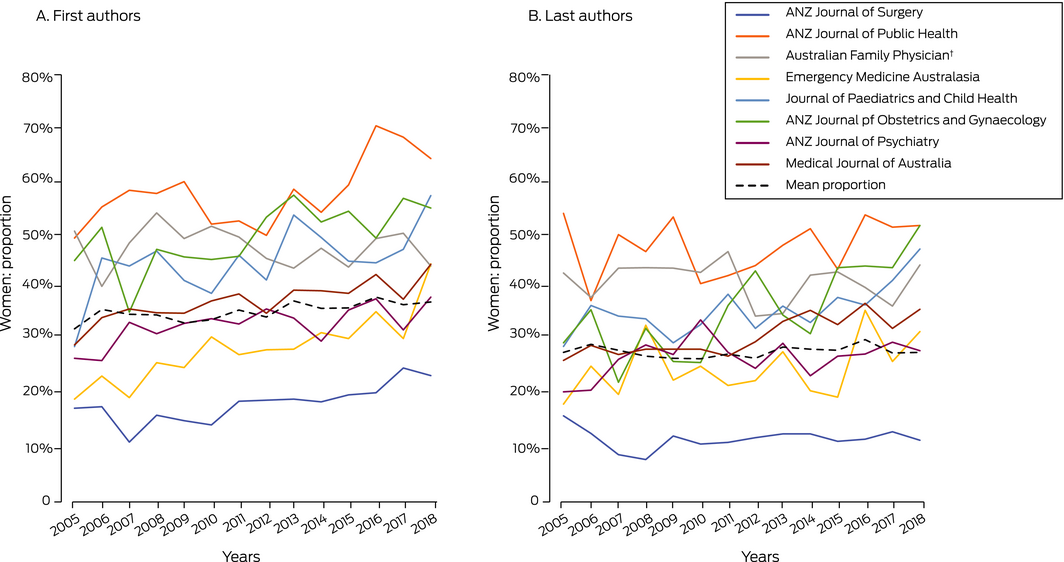In June 2015, 41% of Australian medical specialists were women,1 but only 28% of those in senior or leadership positions.2 Academic research is important for obtaining tenure and promotion in medicine. First authorship on publications is typically granted to junior authors and last authorship to directing senior authors. The proportion of women among first authors in six prominent American medical journals increased from 5.9% in 1970 to 29.3% in 2004, and for last authorship from 3.7% to 19.3%.3 However, a 2016 study found that the proportion of authors who were women in high impact medical journals had plateaued or declined since 2009.4 Examining Australian patterns of authorship could help identify barriers to the academic advancement of women in medicine.
We identified in PubMed all journal articles published during 2005–2018 by the eight journals associated with peak bodies of Australian medical practitioners, and used the validated genderize.R tool to determine the probable gender of authors’ first names.5 We used Poisson regression to analyse first and last authorship (male = 0, female = 1) by year; we report the statistical significance of the deviation of the regression slope (B‐value) from zero. The relationship between number of authors and gender were assessed by linear regression, including an interaction term between gender and time. Formal ethics approval was not required for this analysis of publicly available data.
Gender could be determined with at least 50% probability for the first authors of 26 621 of 27 804 articles (96%) and the last authors of 26 972 (97%). Between 2005 and 2018, the proportion of women among first authors in the eight journals increased from 522 of 1600 (32.6%) to 899 of 2391 (37.6%; P < 0.001); the proportion among last authors did not change (28.0%).
The proportions of women among both first and last authors increased significantly in the Journal of Paediatrics and Child Health, the Australian and New Zealand Journal of Obstetrics and Gynaecology, and the Medical Journal of Australia, as did those of first authors (but not last authors) in the Australian and New Zealand Journal of Public Health, Emergency Medicine Australasia, the Australian and New Zealand Journal of Psychiatry, and the Australian and New Zealand Journal of Surgery; the proportions of neither changed significantly in Australian Family Physician (Box; Supporting Information, table 1). The mean number of authors on publications with women as first authors (3.8; standard deviation [SD], 2.4) was higher than for those with men as first authors (3.3; SD, 2.4; P < 0.001). The difference between author numbers was smaller, but statistically significant, with respect to last author gender (women: mean number of authors, 3.6; SD, 2.4; men: 3.5; SD, 2.4; P = 0.045) (Supporting Information, tables 2, 3).
Our study did not distinguish between research, review, and other journal article types. While our findings may reflect overall involvement of women in research, they do not specifically define gender proportions among leaders of high impact academic research programs.
The increase in the proportion of first authors of Australian medical journal articles who are women may reflect the rise in the proportion of female doctors from 33% to 43% between January 2006 and December 2018.1 It is also possible that women, under‐represented in their specialties, feel greater pressure than men to publish as first authors for purposes of career progression.2 Our data indicate that the proportion of women as first authors has increased, but that of last authorship has grown only in some specialities.
Box – Proportions of women as first and last authors of articles in selected Australian medical journals, 2005–2018*

* The raw data are included in the online Supporting Information, tables 4 and 5. † From 2018: the Australian Journal of General Practice.
Received 15 June 2020, accepted 29 January 2021
- 1. Medical Board of Australia; Australian Health Practitioner Regulation Agency. Statistics: registration data. https://www.medicalboard.gov.au/News/Statistics.aspx (viewed Nov 2020).
- 2. Bismark M, Morris J, Thomas L, et al. Reasons and remedies for under‐representation of women in medical leadership roles: a qualitative study from Australia. BMJ Open 2015; 5: e009384.
- 3. Jagsi R, Guancial EA, Worobey CC, et al. The “gender gap” in authorship of academic medical literature: a 35‐year perspective. N Engl J Med 2006; 355: 281–287.
- 4. Filardo G, da Graca B, Sass DM, et al. Trends and comparison of female first authorship in high impact medical journals: observational study (1994–2014). BMJ 2016; 352: i847.
- 5. Wais K. genderizeR: Gender prediction based on first names. R package version 2.0.0. https://cran.r-project.org/src/contrib/Archive/genderizeR (viewed Nov 2020).





No relevant disclosures.